Super Human Figures in Mughal Art: Historical and Cultural Study
VerifiedAdded on 2024/05/17
|29
|9593
|86
Essay
AI Summary
This essay explores the presence of super human figures, such as angels and fairies, in Mughal art from 1526 to 1858, focusing on the reigns of Akbar, Jahangir, and Shah Jahan. It examines how Mughal rulers used art to express their views and beliefs to a diverse population, highlighting the influence of European paintings on Mughal artistic styles, particularly during Jahangir's rule. The study delves into specific examples like the paintings in the Kala Burj at Lahore Fort, analyzing the cultural and historical significance of these winged figures and their broader impact on Mughal architecture and art. The research also touches upon the incorporation of these figures into Hindu courts and various manuscripts, reflecting the dynasty's efforts to blend diverse cultural elements into their artistic expressions.
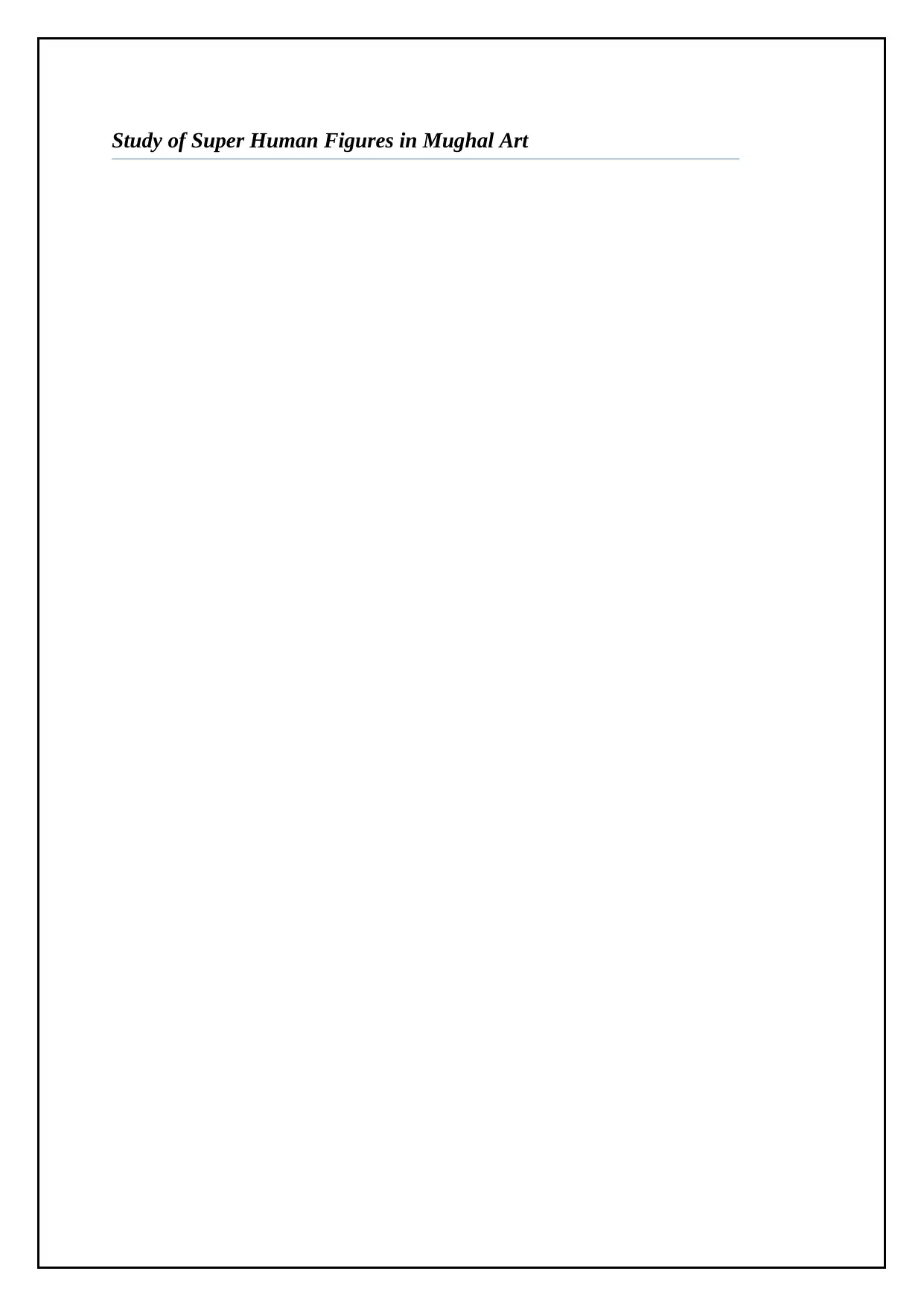
Study of Super Human Figures in Mughal Art
Paraphrase This Document
Need a fresh take? Get an instant paraphrase of this document with our AI Paraphraser
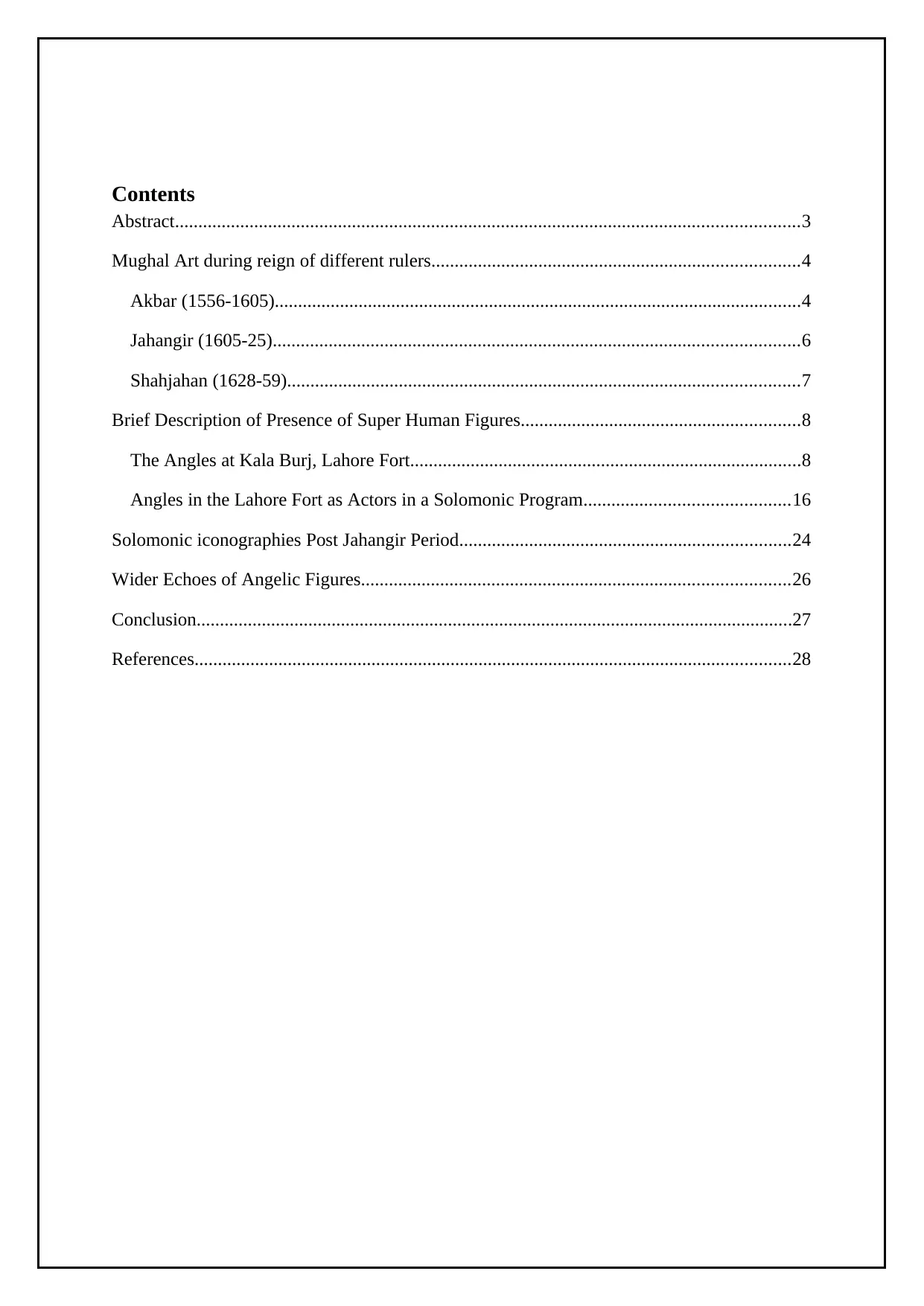
Contents
Abstract......................................................................................................................................3
Mughal Art during reign of different rulers...............................................................................4
Akbar (1556-1605).................................................................................................................4
Jahangir (1605-25).................................................................................................................6
Shahjahan (1628-59)..............................................................................................................7
Brief Description of Presence of Super Human Figures............................................................8
The Angles at Kala Burj, Lahore Fort....................................................................................8
Angles in the Lahore Fort as Actors in a Solomonic Program............................................16
Solomonic iconographies Post Jahangir Period.......................................................................24
Wider Echoes of Angelic Figures............................................................................................26
Conclusion................................................................................................................................27
References................................................................................................................................28
Abstract......................................................................................................................................3
Mughal Art during reign of different rulers...............................................................................4
Akbar (1556-1605).................................................................................................................4
Jahangir (1605-25).................................................................................................................6
Shahjahan (1628-59)..............................................................................................................7
Brief Description of Presence of Super Human Figures............................................................8
The Angles at Kala Burj, Lahore Fort....................................................................................8
Angles in the Lahore Fort as Actors in a Solomonic Program............................................16
Solomonic iconographies Post Jahangir Period.......................................................................24
Wider Echoes of Angelic Figures............................................................................................26
Conclusion................................................................................................................................27
References................................................................................................................................28
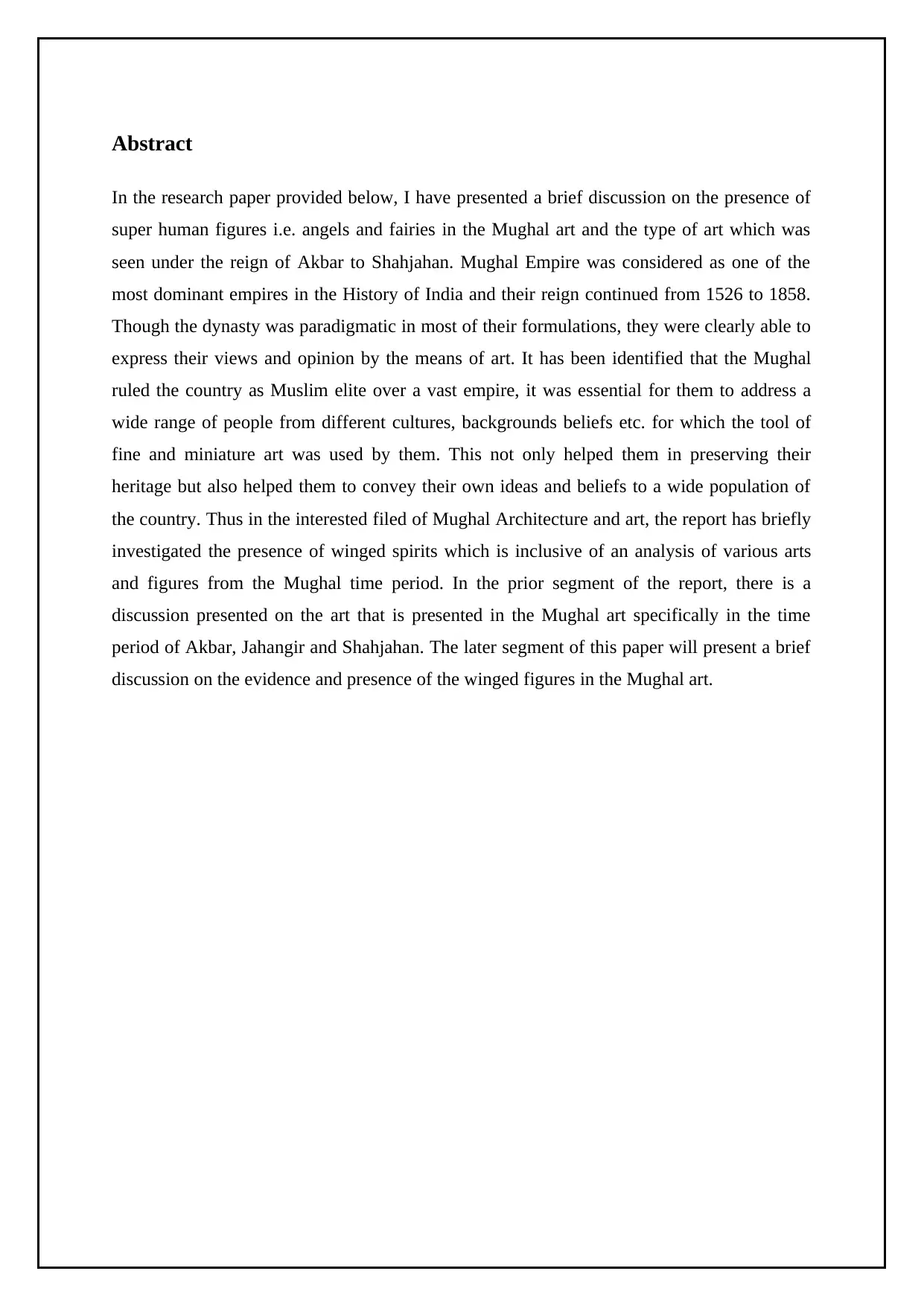
Abstract
In the research paper provided below, I have presented a brief discussion on the presence of
super human figures i.e. angels and fairies in the Mughal art and the type of art which was
seen under the reign of Akbar to Shahjahan. Mughal Empire was considered as one of the
most dominant empires in the History of India and their reign continued from 1526 to 1858.
Though the dynasty was paradigmatic in most of their formulations, they were clearly able to
express their views and opinion by the means of art. It has been identified that the Mughal
ruled the country as Muslim elite over a vast empire, it was essential for them to address a
wide range of people from different cultures, backgrounds beliefs etc. for which the tool of
fine and miniature art was used by them. This not only helped them in preserving their
heritage but also helped them to convey their own ideas and beliefs to a wide population of
the country. Thus in the interested filed of Mughal Architecture and art, the report has briefly
investigated the presence of winged spirits which is inclusive of an analysis of various arts
and figures from the Mughal time period. In the prior segment of the report, there is a
discussion presented on the art that is presented in the Mughal art specifically in the time
period of Akbar, Jahangir and Shahjahan. The later segment of this paper will present a brief
discussion on the evidence and presence of the winged figures in the Mughal art.
In the research paper provided below, I have presented a brief discussion on the presence of
super human figures i.e. angels and fairies in the Mughal art and the type of art which was
seen under the reign of Akbar to Shahjahan. Mughal Empire was considered as one of the
most dominant empires in the History of India and their reign continued from 1526 to 1858.
Though the dynasty was paradigmatic in most of their formulations, they were clearly able to
express their views and opinion by the means of art. It has been identified that the Mughal
ruled the country as Muslim elite over a vast empire, it was essential for them to address a
wide range of people from different cultures, backgrounds beliefs etc. for which the tool of
fine and miniature art was used by them. This not only helped them in preserving their
heritage but also helped them to convey their own ideas and beliefs to a wide population of
the country. Thus in the interested filed of Mughal Architecture and art, the report has briefly
investigated the presence of winged spirits which is inclusive of an analysis of various arts
and figures from the Mughal time period. In the prior segment of the report, there is a
discussion presented on the art that is presented in the Mughal art specifically in the time
period of Akbar, Jahangir and Shahjahan. The later segment of this paper will present a brief
discussion on the evidence and presence of the winged figures in the Mughal art.
⊘ This is a preview!⊘
Do you want full access?
Subscribe today to unlock all pages.

Trusted by 1+ million students worldwide
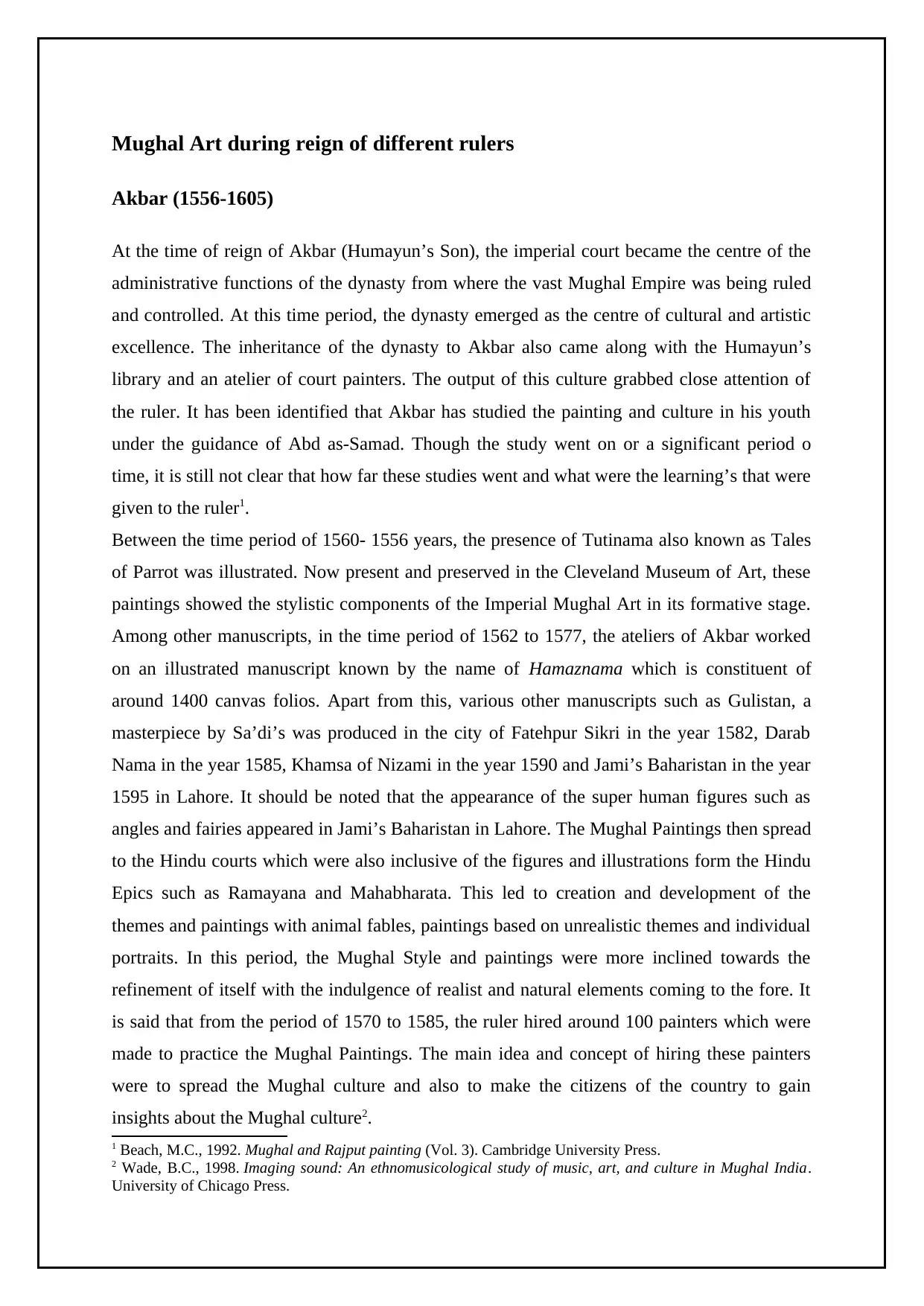
Mughal Art during reign of different rulers
Akbar (1556-1605)
At the time of reign of Akbar (Humayun’s Son), the imperial court became the centre of the
administrative functions of the dynasty from where the vast Mughal Empire was being ruled
and controlled. At this time period, the dynasty emerged as the centre of cultural and artistic
excellence. The inheritance of the dynasty to Akbar also came along with the Humayun’s
library and an atelier of court painters. The output of this culture grabbed close attention of
the ruler. It has been identified that Akbar has studied the painting and culture in his youth
under the guidance of Abd as-Samad. Though the study went on or a significant period o
time, it is still not clear that how far these studies went and what were the learning’s that were
given to the ruler1.
Between the time period of 1560- 1556 years, the presence of Tutinama also known as Tales
of Parrot was illustrated. Now present and preserved in the Cleveland Museum of Art, these
paintings showed the stylistic components of the Imperial Mughal Art in its formative stage.
Among other manuscripts, in the time period of 1562 to 1577, the ateliers of Akbar worked
on an illustrated manuscript known by the name of Hamaznama which is constituent of
around 1400 canvas folios. Apart from this, various other manuscripts such as Gulistan, a
masterpiece by Sa’di’s was produced in the city of Fatehpur Sikri in the year 1582, Darab
Nama in the year 1585, Khamsa of Nizami in the year 1590 and Jami’s Baharistan in the year
1595 in Lahore. It should be noted that the appearance of the super human figures such as
angles and fairies appeared in Jami’s Baharistan in Lahore. The Mughal Paintings then spread
to the Hindu courts which were also inclusive of the figures and illustrations form the Hindu
Epics such as Ramayana and Mahabharata. This led to creation and development of the
themes and paintings with animal fables, paintings based on unrealistic themes and individual
portraits. In this period, the Mughal Style and paintings were more inclined towards the
refinement of itself with the indulgence of realist and natural elements coming to the fore. It
is said that from the period of 1570 to 1585, the ruler hired around 100 painters which were
made to practice the Mughal Paintings. The main idea and concept of hiring these painters
were to spread the Mughal culture and also to make the citizens of the country to gain
insights about the Mughal culture2.
1 Beach, M.C., 1992. Mughal and Rajput painting (Vol. 3). Cambridge University Press.
2 Wade, B.C., 1998. Imaging sound: An ethnomusicological study of music, art, and culture in Mughal India.
University of Chicago Press.
Akbar (1556-1605)
At the time of reign of Akbar (Humayun’s Son), the imperial court became the centre of the
administrative functions of the dynasty from where the vast Mughal Empire was being ruled
and controlled. At this time period, the dynasty emerged as the centre of cultural and artistic
excellence. The inheritance of the dynasty to Akbar also came along with the Humayun’s
library and an atelier of court painters. The output of this culture grabbed close attention of
the ruler. It has been identified that Akbar has studied the painting and culture in his youth
under the guidance of Abd as-Samad. Though the study went on or a significant period o
time, it is still not clear that how far these studies went and what were the learning’s that were
given to the ruler1.
Between the time period of 1560- 1556 years, the presence of Tutinama also known as Tales
of Parrot was illustrated. Now present and preserved in the Cleveland Museum of Art, these
paintings showed the stylistic components of the Imperial Mughal Art in its formative stage.
Among other manuscripts, in the time period of 1562 to 1577, the ateliers of Akbar worked
on an illustrated manuscript known by the name of Hamaznama which is constituent of
around 1400 canvas folios. Apart from this, various other manuscripts such as Gulistan, a
masterpiece by Sa’di’s was produced in the city of Fatehpur Sikri in the year 1582, Darab
Nama in the year 1585, Khamsa of Nizami in the year 1590 and Jami’s Baharistan in the year
1595 in Lahore. It should be noted that the appearance of the super human figures such as
angles and fairies appeared in Jami’s Baharistan in Lahore. The Mughal Paintings then spread
to the Hindu courts which were also inclusive of the figures and illustrations form the Hindu
Epics such as Ramayana and Mahabharata. This led to creation and development of the
themes and paintings with animal fables, paintings based on unrealistic themes and individual
portraits. In this period, the Mughal Style and paintings were more inclined towards the
refinement of itself with the indulgence of realist and natural elements coming to the fore. It
is said that from the period of 1570 to 1585, the ruler hired around 100 painters which were
made to practice the Mughal Paintings. The main idea and concept of hiring these painters
were to spread the Mughal culture and also to make the citizens of the country to gain
insights about the Mughal culture2.
1 Beach, M.C., 1992. Mughal and Rajput painting (Vol. 3). Cambridge University Press.
2 Wade, B.C., 1998. Imaging sound: An ethnomusicological study of music, art, and culture in Mughal India.
University of Chicago Press.
Paraphrase This Document
Need a fresh take? Get an instant paraphrase of this document with our AI Paraphraser
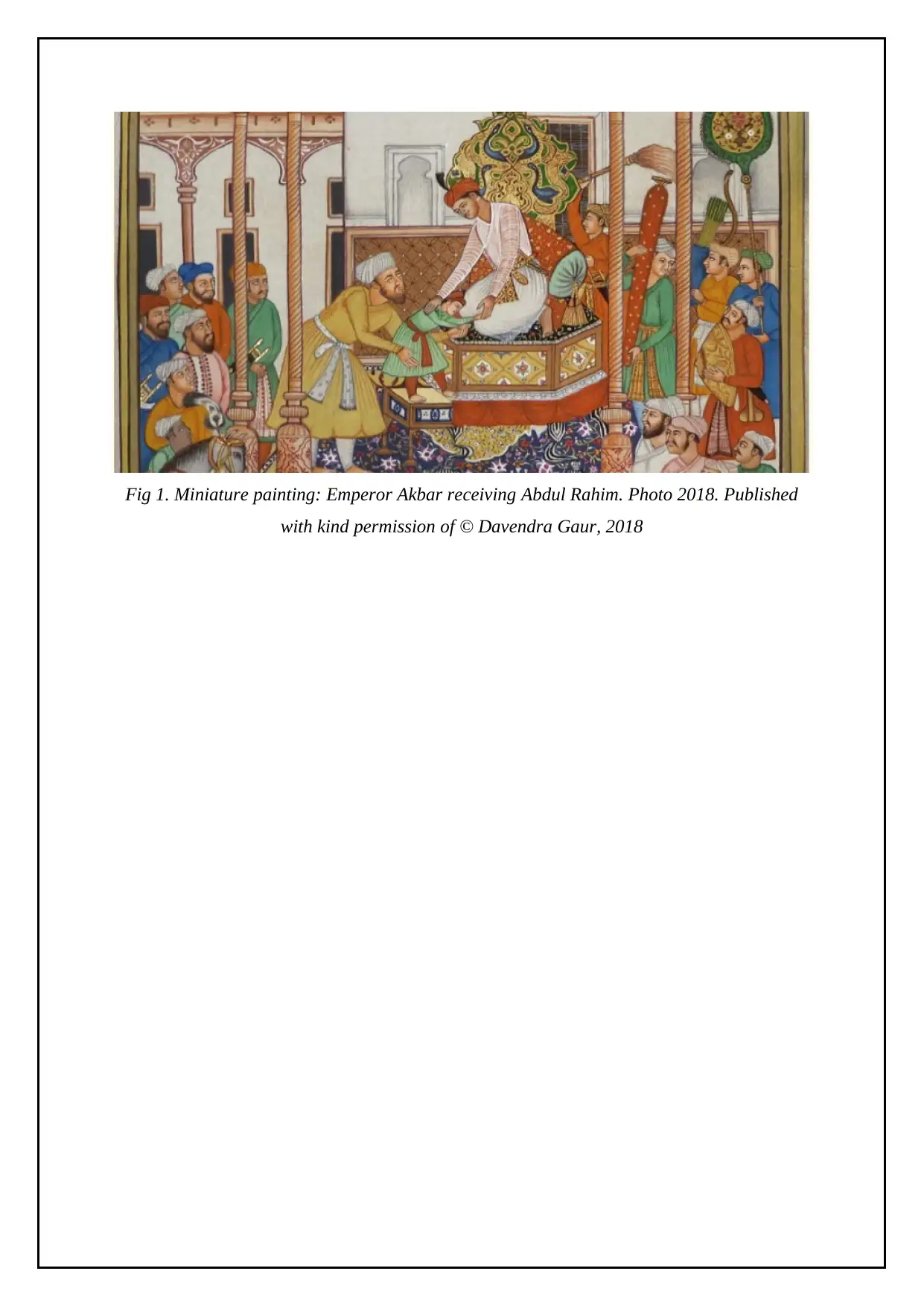
Fig 1. Miniature painting: Emperor Akbar receiving Abdul Rahim. Photo 2018. Published
with kind permission of © Davendra Gaur, 2018
with kind permission of © Davendra Gaur, 2018
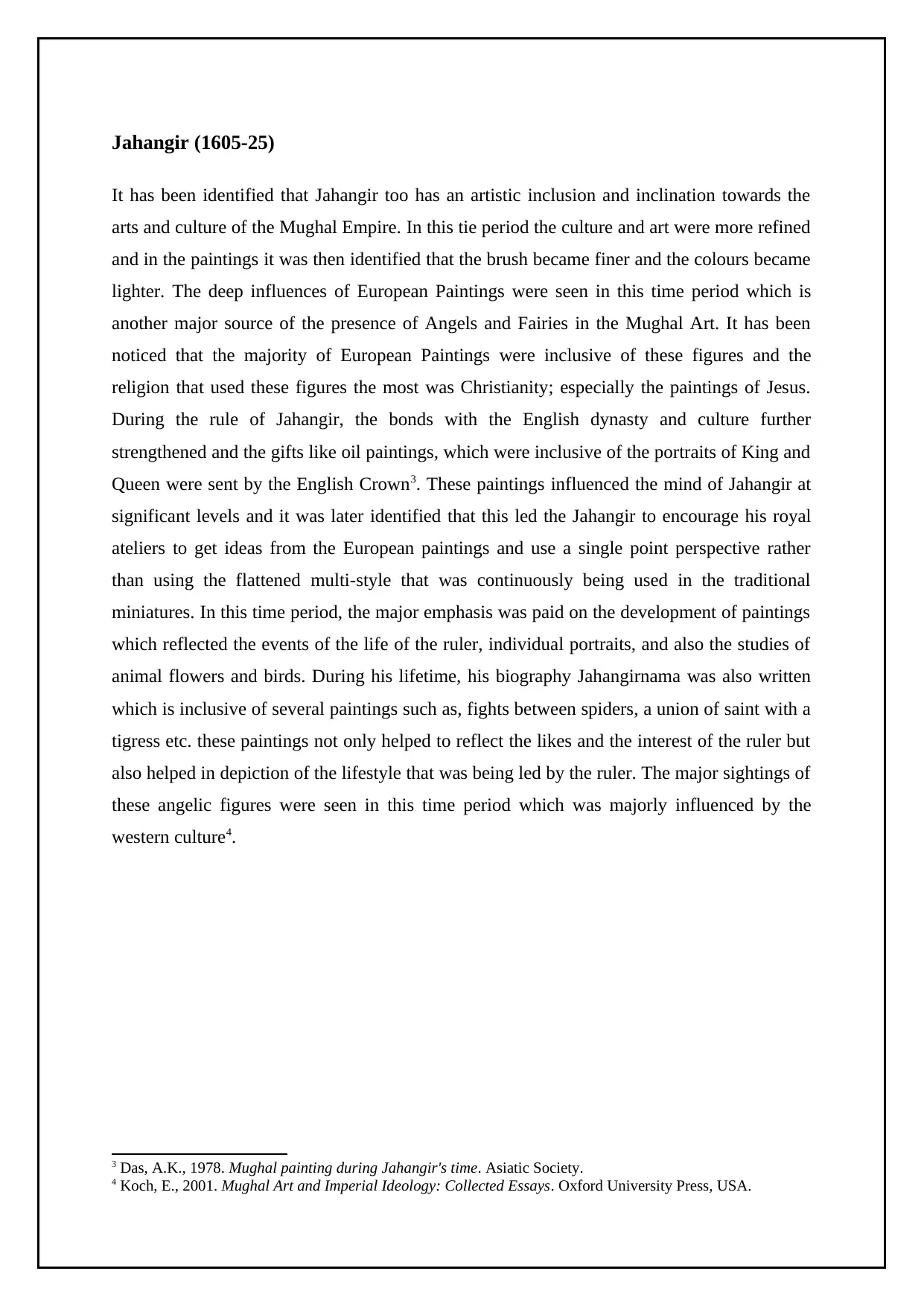
Jahangir (1605-25)
It has been identified that Jahangir too has an artistic inclusion and inclination towards the
arts and culture of the Mughal Empire. In this tie period the culture and art were more refined
and in the paintings it was then identified that the brush became finer and the colours became
lighter. The deep influences of European Paintings were seen in this time period which is
another major source of the presence of Angels and Fairies in the Mughal Art. It has been
noticed that the majority of European Paintings were inclusive of these figures and the
religion that used these figures the most was Christianity; especially the paintings of Jesus.
During the rule of Jahangir, the bonds with the English dynasty and culture further
strengthened and the gifts like oil paintings, which were inclusive of the portraits of King and
Queen were sent by the English Crown3. These paintings influenced the mind of Jahangir at
significant levels and it was later identified that this led the Jahangir to encourage his royal
ateliers to get ideas from the European paintings and use a single point perspective rather
than using the flattened multi-style that was continuously being used in the traditional
miniatures. In this time period, the major emphasis was paid on the development of paintings
which reflected the events of the life of the ruler, individual portraits, and also the studies of
animal flowers and birds. During his lifetime, his biography Jahangirnama was also written
which is inclusive of several paintings such as, fights between spiders, a union of saint with a
tigress etc. these paintings not only helped to reflect the likes and the interest of the ruler but
also helped in depiction of the lifestyle that was being led by the ruler. The major sightings of
these angelic figures were seen in this time period which was majorly influenced by the
western culture4.
3 Das, A.K., 1978. Mughal painting during Jahangir's time. Asiatic Society.
4 Koch, E., 2001. Mughal Art and Imperial Ideology: Collected Essays. Oxford University Press, USA.
It has been identified that Jahangir too has an artistic inclusion and inclination towards the
arts and culture of the Mughal Empire. In this tie period the culture and art were more refined
and in the paintings it was then identified that the brush became finer and the colours became
lighter. The deep influences of European Paintings were seen in this time period which is
another major source of the presence of Angels and Fairies in the Mughal Art. It has been
noticed that the majority of European Paintings were inclusive of these figures and the
religion that used these figures the most was Christianity; especially the paintings of Jesus.
During the rule of Jahangir, the bonds with the English dynasty and culture further
strengthened and the gifts like oil paintings, which were inclusive of the portraits of King and
Queen were sent by the English Crown3. These paintings influenced the mind of Jahangir at
significant levels and it was later identified that this led the Jahangir to encourage his royal
ateliers to get ideas from the European paintings and use a single point perspective rather
than using the flattened multi-style that was continuously being used in the traditional
miniatures. In this time period, the major emphasis was paid on the development of paintings
which reflected the events of the life of the ruler, individual portraits, and also the studies of
animal flowers and birds. During his lifetime, his biography Jahangirnama was also written
which is inclusive of several paintings such as, fights between spiders, a union of saint with a
tigress etc. these paintings not only helped to reflect the likes and the interest of the ruler but
also helped in depiction of the lifestyle that was being led by the ruler. The major sightings of
these angelic figures were seen in this time period which was majorly influenced by the
western culture4.
3 Das, A.K., 1978. Mughal painting during Jahangir's time. Asiatic Society.
4 Koch, E., 2001. Mughal Art and Imperial Ideology: Collected Essays. Oxford University Press, USA.
⊘ This is a preview!⊘
Do you want full access?
Subscribe today to unlock all pages.

Trusted by 1+ million students worldwide
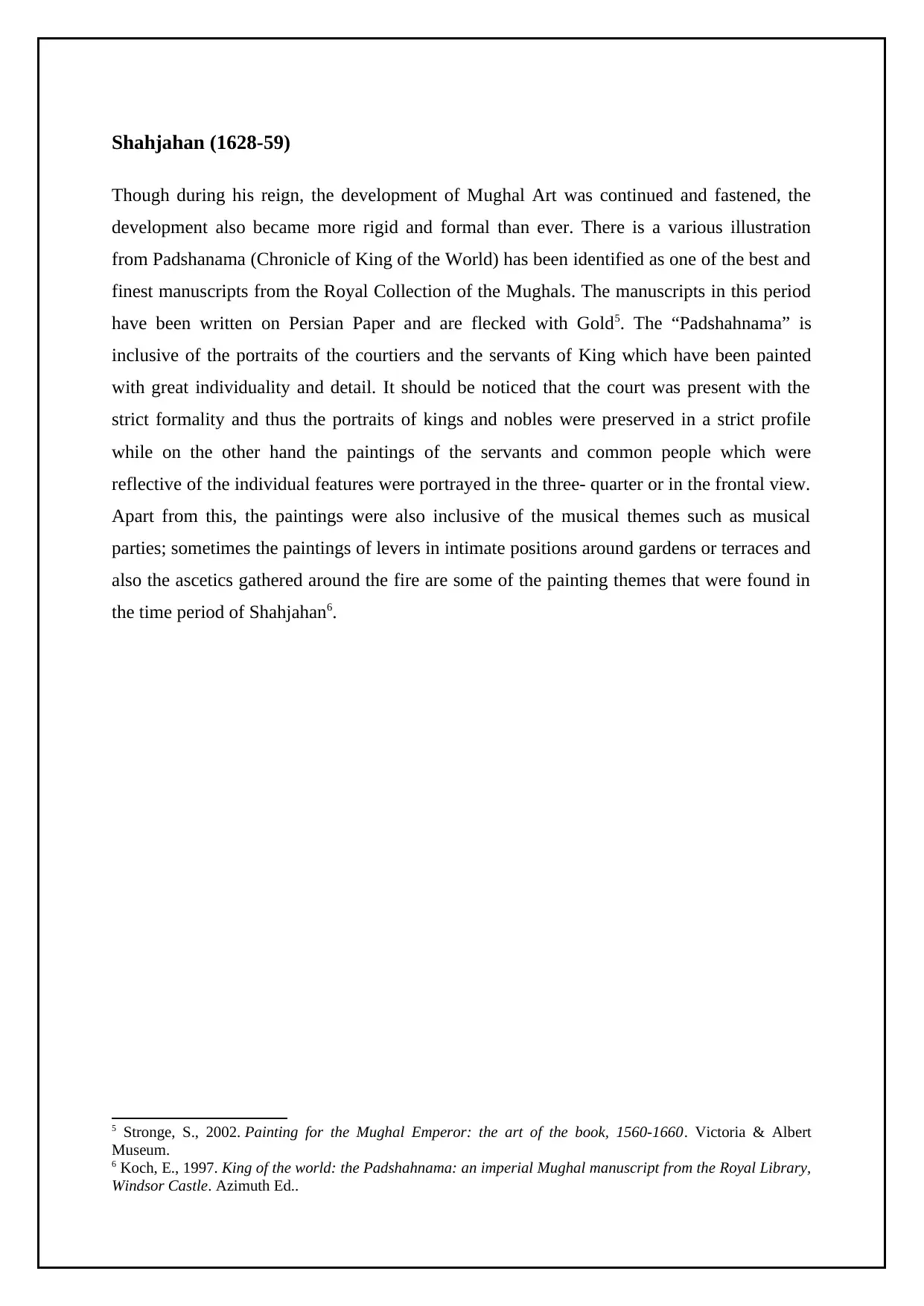
Shahjahan (1628-59)
Though during his reign, the development of Mughal Art was continued and fastened, the
development also became more rigid and formal than ever. There is a various illustration
from Padshanama (Chronicle of King of the World) has been identified as one of the best and
finest manuscripts from the Royal Collection of the Mughals. The manuscripts in this period
have been written on Persian Paper and are flecked with Gold5. The “Padshahnama” is
inclusive of the portraits of the courtiers and the servants of King which have been painted
with great individuality and detail. It should be noticed that the court was present with the
strict formality and thus the portraits of kings and nobles were preserved in a strict profile
while on the other hand the paintings of the servants and common people which were
reflective of the individual features were portrayed in the three- quarter or in the frontal view.
Apart from this, the paintings were also inclusive of the musical themes such as musical
parties; sometimes the paintings of levers in intimate positions around gardens or terraces and
also the ascetics gathered around the fire are some of the painting themes that were found in
the time period of Shahjahan6.
5 Stronge, S., 2002. Painting for the Mughal Emperor: the art of the book, 1560-1660. Victoria & Albert
Museum.
6 Koch, E., 1997. King of the world: the Padshahnama: an imperial Mughal manuscript from the Royal Library,
Windsor Castle. Azimuth Ed..
Though during his reign, the development of Mughal Art was continued and fastened, the
development also became more rigid and formal than ever. There is a various illustration
from Padshanama (Chronicle of King of the World) has been identified as one of the best and
finest manuscripts from the Royal Collection of the Mughals. The manuscripts in this period
have been written on Persian Paper and are flecked with Gold5. The “Padshahnama” is
inclusive of the portraits of the courtiers and the servants of King which have been painted
with great individuality and detail. It should be noticed that the court was present with the
strict formality and thus the portraits of kings and nobles were preserved in a strict profile
while on the other hand the paintings of the servants and common people which were
reflective of the individual features were portrayed in the three- quarter or in the frontal view.
Apart from this, the paintings were also inclusive of the musical themes such as musical
parties; sometimes the paintings of levers in intimate positions around gardens or terraces and
also the ascetics gathered around the fire are some of the painting themes that were found in
the time period of Shahjahan6.
5 Stronge, S., 2002. Painting for the Mughal Emperor: the art of the book, 1560-1660. Victoria & Albert
Museum.
6 Koch, E., 1997. King of the world: the Padshahnama: an imperial Mughal manuscript from the Royal Library,
Windsor Castle. Azimuth Ed..
Paraphrase This Document
Need a fresh take? Get an instant paraphrase of this document with our AI Paraphraser
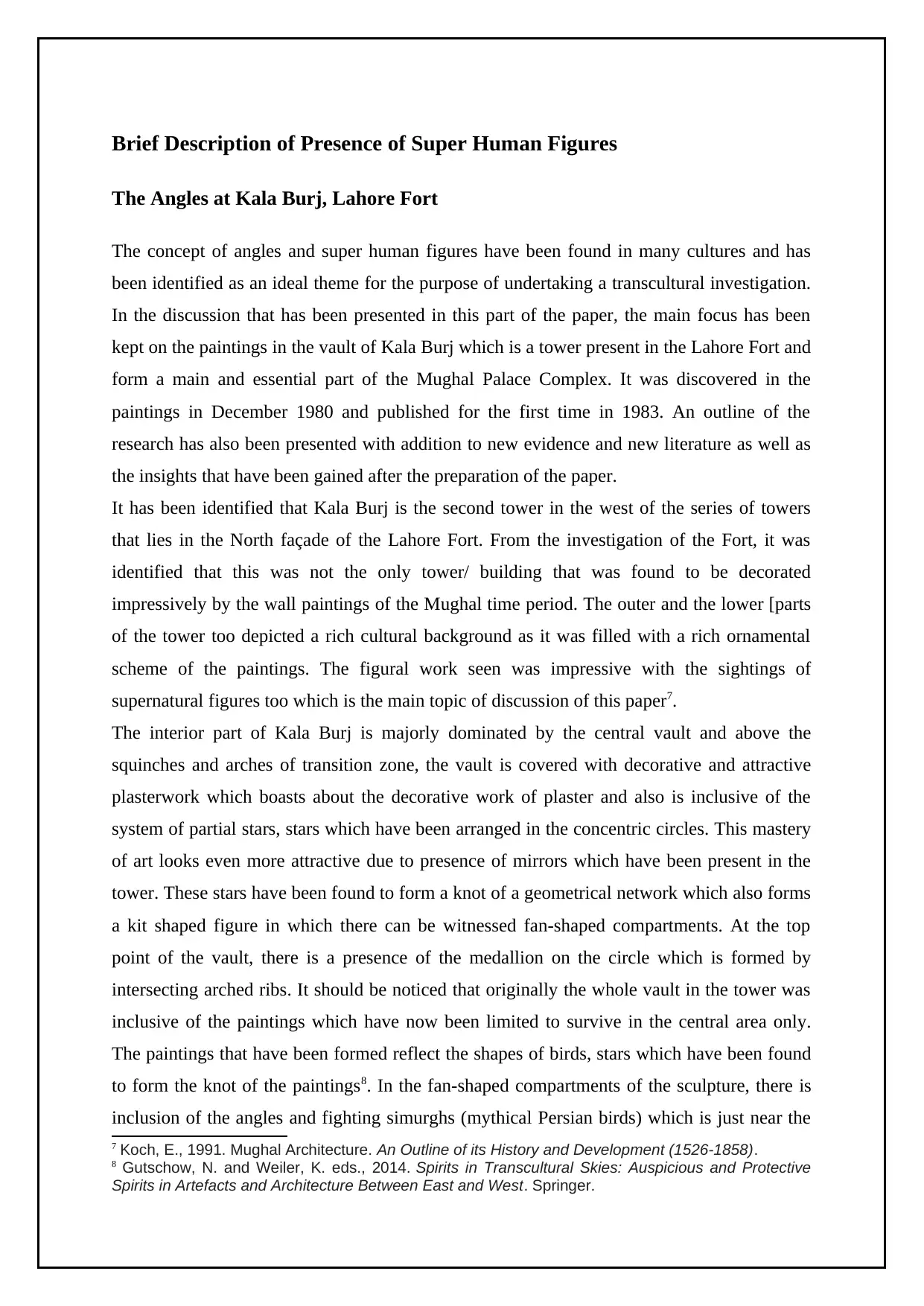
Brief Description of Presence of Super Human Figures
The Angles at Kala Burj, Lahore Fort
The concept of angles and super human figures have been found in many cultures and has
been identified as an ideal theme for the purpose of undertaking a transcultural investigation.
In the discussion that has been presented in this part of the paper, the main focus has been
kept on the paintings in the vault of Kala Burj which is a tower present in the Lahore Fort and
form a main and essential part of the Mughal Palace Complex. It was discovered in the
paintings in December 1980 and published for the first time in 1983. An outline of the
research has also been presented with addition to new evidence and new literature as well as
the insights that have been gained after the preparation of the paper.
It has been identified that Kala Burj is the second tower in the west of the series of towers
that lies in the North façade of the Lahore Fort. From the investigation of the Fort, it was
identified that this was not the only tower/ building that was found to be decorated
impressively by the wall paintings of the Mughal time period. The outer and the lower [parts
of the tower too depicted a rich cultural background as it was filled with a rich ornamental
scheme of the paintings. The figural work seen was impressive with the sightings of
supernatural figures too which is the main topic of discussion of this paper7.
The interior part of Kala Burj is majorly dominated by the central vault and above the
squinches and arches of transition zone, the vault is covered with decorative and attractive
plasterwork which boasts about the decorative work of plaster and also is inclusive of the
system of partial stars, stars which have been arranged in the concentric circles. This mastery
of art looks even more attractive due to presence of mirrors which have been present in the
tower. These stars have been found to form a knot of a geometrical network which also forms
a kit shaped figure in which there can be witnessed fan-shaped compartments. At the top
point of the vault, there is a presence of the medallion on the circle which is formed by
intersecting arched ribs. It should be noticed that originally the whole vault in the tower was
inclusive of the paintings which have now been limited to survive in the central area only.
The paintings that have been formed reflect the shapes of birds, stars which have been found
to form the knot of the paintings8. In the fan-shaped compartments of the sculpture, there is
inclusion of the angles and fighting simurghs (mythical Persian birds) which is just near the
7 Koch, E., 1991. Mughal Architecture. An Outline of its History and Development (1526-1858).
8 Gutschow, N. and Weiler, K. eds., 2014. Spirits in Transcultural Skies: Auspicious and Protective
Spirits in Artefacts and Architecture Between East and West. Springer.
The Angles at Kala Burj, Lahore Fort
The concept of angles and super human figures have been found in many cultures and has
been identified as an ideal theme for the purpose of undertaking a transcultural investigation.
In the discussion that has been presented in this part of the paper, the main focus has been
kept on the paintings in the vault of Kala Burj which is a tower present in the Lahore Fort and
form a main and essential part of the Mughal Palace Complex. It was discovered in the
paintings in December 1980 and published for the first time in 1983. An outline of the
research has also been presented with addition to new evidence and new literature as well as
the insights that have been gained after the preparation of the paper.
It has been identified that Kala Burj is the second tower in the west of the series of towers
that lies in the North façade of the Lahore Fort. From the investigation of the Fort, it was
identified that this was not the only tower/ building that was found to be decorated
impressively by the wall paintings of the Mughal time period. The outer and the lower [parts
of the tower too depicted a rich cultural background as it was filled with a rich ornamental
scheme of the paintings. The figural work seen was impressive with the sightings of
supernatural figures too which is the main topic of discussion of this paper7.
The interior part of Kala Burj is majorly dominated by the central vault and above the
squinches and arches of transition zone, the vault is covered with decorative and attractive
plasterwork which boasts about the decorative work of plaster and also is inclusive of the
system of partial stars, stars which have been arranged in the concentric circles. This mastery
of art looks even more attractive due to presence of mirrors which have been present in the
tower. These stars have been found to form a knot of a geometrical network which also forms
a kit shaped figure in which there can be witnessed fan-shaped compartments. At the top
point of the vault, there is a presence of the medallion on the circle which is formed by
intersecting arched ribs. It should be noticed that originally the whole vault in the tower was
inclusive of the paintings which have now been limited to survive in the central area only.
The paintings that have been formed reflect the shapes of birds, stars which have been found
to form the knot of the paintings8. In the fan-shaped compartments of the sculpture, there is
inclusion of the angles and fighting simurghs (mythical Persian birds) which is just near the
7 Koch, E., 1991. Mughal Architecture. An Outline of its History and Development (1526-1858).
8 Gutschow, N. and Weiler, K. eds., 2014. Spirits in Transcultural Skies: Auspicious and Protective
Spirits in Artefacts and Architecture Between East and West. Springer.
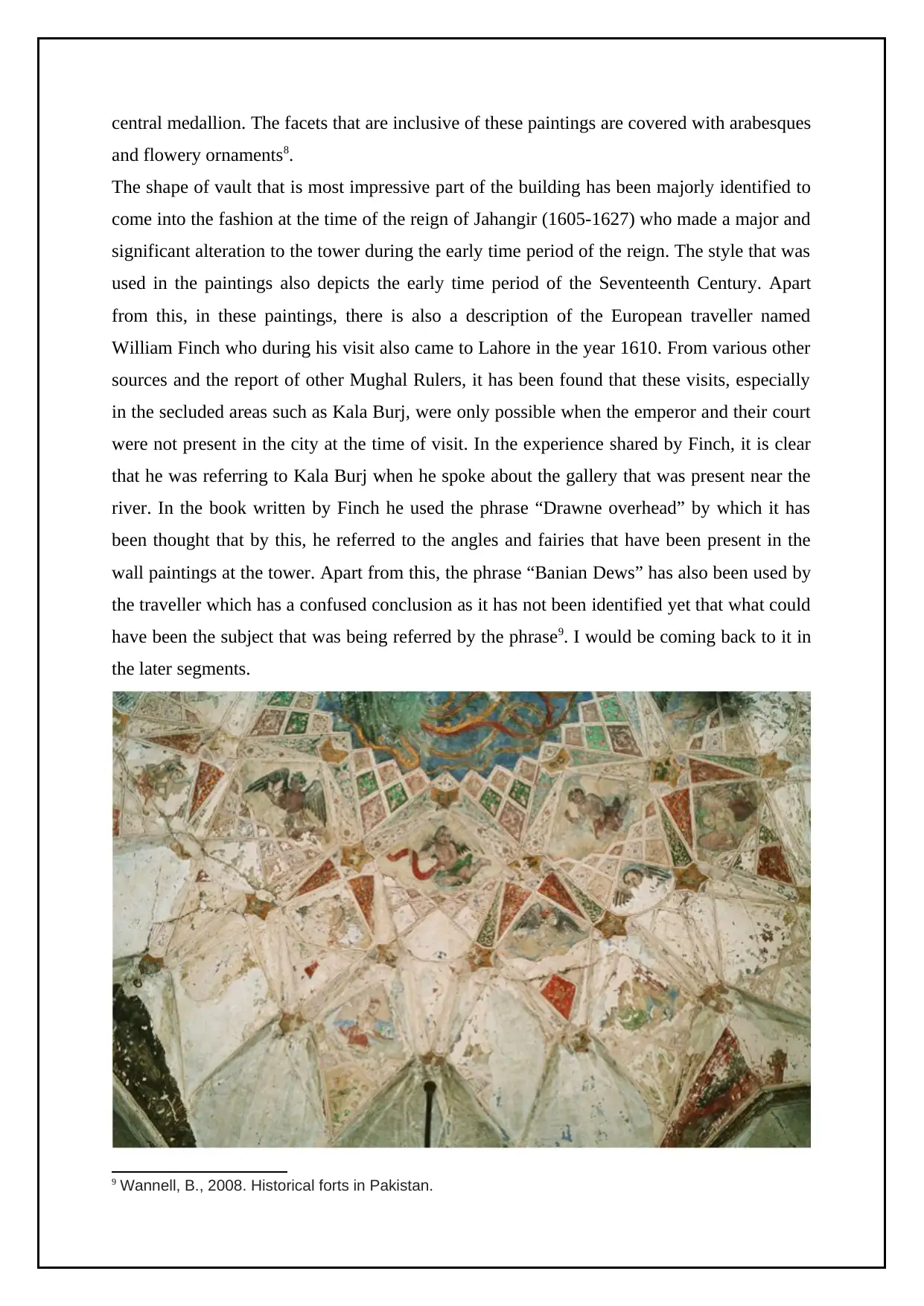
central medallion. The facets that are inclusive of these paintings are covered with arabesques
and flowery ornaments8.
The shape of vault that is most impressive part of the building has been majorly identified to
come into the fashion at the time of the reign of Jahangir (1605-1627) who made a major and
significant alteration to the tower during the early time period of the reign. The style that was
used in the paintings also depicts the early time period of the Seventeenth Century. Apart
from this, in these paintings, there is also a description of the European traveller named
William Finch who during his visit also came to Lahore in the year 1610. From various other
sources and the report of other Mughal Rulers, it has been found that these visits, especially
in the secluded areas such as Kala Burj, were only possible when the emperor and their court
were not present in the city at the time of visit. In the experience shared by Finch, it is clear
that he was referring to Kala Burj when he spoke about the gallery that was present near the
river. In the book written by Finch he used the phrase “Drawne overhead” by which it has
been thought that by this, he referred to the angles and fairies that have been present in the
wall paintings at the tower. Apart from this, the phrase “Banian Dews” has also been used by
the traveller which has a confused conclusion as it has not been identified yet that what could
have been the subject that was being referred by the phrase9. I would be coming back to it in
the later segments.
9 Wannell, B., 2008. Historical forts in Pakistan.
and flowery ornaments8.
The shape of vault that is most impressive part of the building has been majorly identified to
come into the fashion at the time of the reign of Jahangir (1605-1627) who made a major and
significant alteration to the tower during the early time period of the reign. The style that was
used in the paintings also depicts the early time period of the Seventeenth Century. Apart
from this, in these paintings, there is also a description of the European traveller named
William Finch who during his visit also came to Lahore in the year 1610. From various other
sources and the report of other Mughal Rulers, it has been found that these visits, especially
in the secluded areas such as Kala Burj, were only possible when the emperor and their court
were not present in the city at the time of visit. In the experience shared by Finch, it is clear
that he was referring to Kala Burj when he spoke about the gallery that was present near the
river. In the book written by Finch he used the phrase “Drawne overhead” by which it has
been thought that by this, he referred to the angles and fairies that have been present in the
wall paintings at the tower. Apart from this, the phrase “Banian Dews” has also been used by
the traveller which has a confused conclusion as it has not been identified yet that what could
have been the subject that was being referred by the phrase9. I would be coming back to it in
the later segments.
9 Wannell, B., 2008. Historical forts in Pakistan.
⊘ This is a preview!⊘
Do you want full access?
Subscribe today to unlock all pages.

Trusted by 1+ million students worldwide
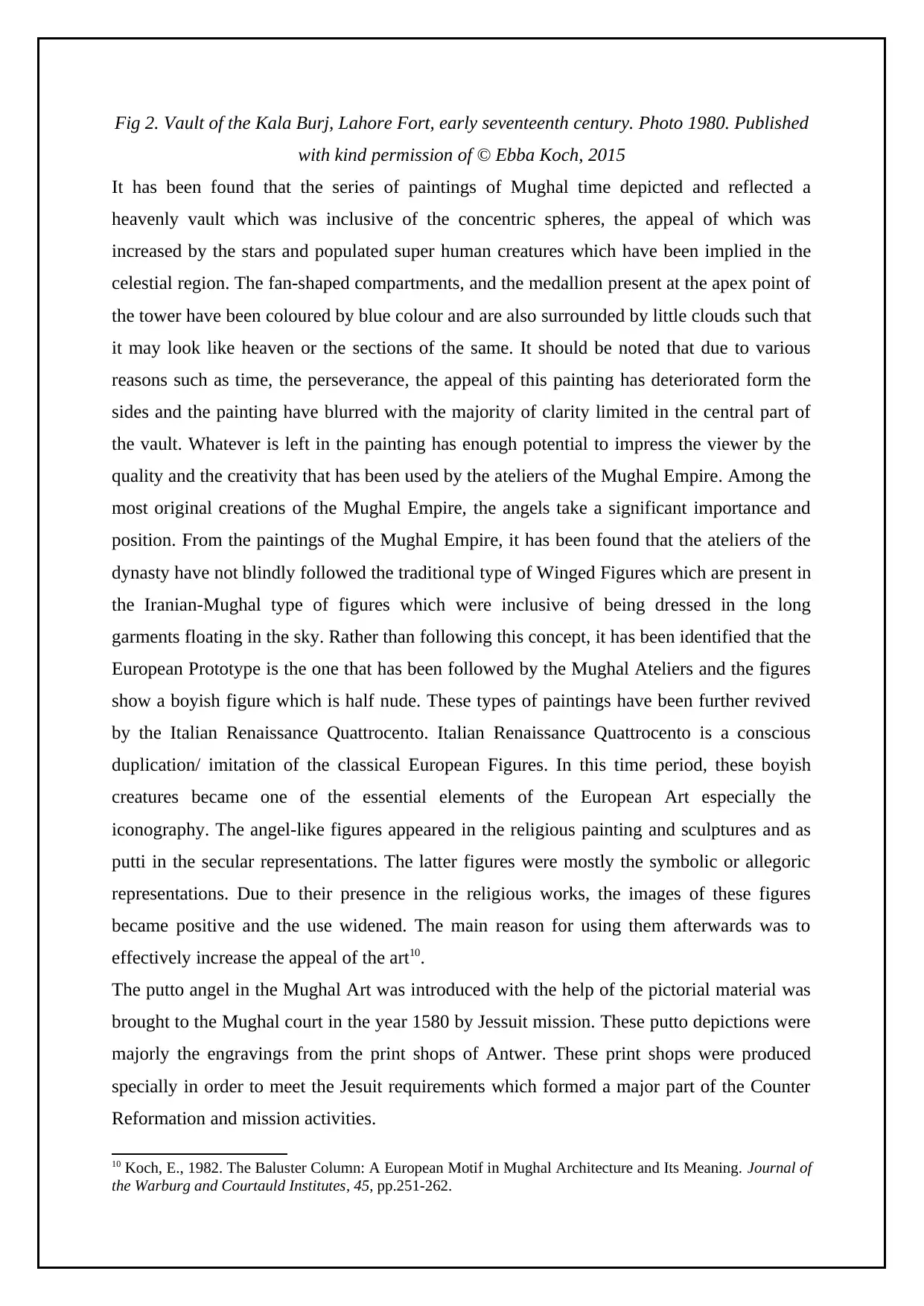
Fig 2. Vault of the Kala Burj, Lahore Fort, early seventeenth century. Photo 1980. Published
with kind permission of © Ebba Koch, 2015
It has been found that the series of paintings of Mughal time depicted and reflected a
heavenly vault which was inclusive of the concentric spheres, the appeal of which was
increased by the stars and populated super human creatures which have been implied in the
celestial region. The fan-shaped compartments, and the medallion present at the apex point of
the tower have been coloured by blue colour and are also surrounded by little clouds such that
it may look like heaven or the sections of the same. It should be noted that due to various
reasons such as time, the perseverance, the appeal of this painting has deteriorated form the
sides and the painting have blurred with the majority of clarity limited in the central part of
the vault. Whatever is left in the painting has enough potential to impress the viewer by the
quality and the creativity that has been used by the ateliers of the Mughal Empire. Among the
most original creations of the Mughal Empire, the angels take a significant importance and
position. From the paintings of the Mughal Empire, it has been found that the ateliers of the
dynasty have not blindly followed the traditional type of Winged Figures which are present in
the Iranian-Mughal type of figures which were inclusive of being dressed in the long
garments floating in the sky. Rather than following this concept, it has been identified that the
European Prototype is the one that has been followed by the Mughal Ateliers and the figures
show a boyish figure which is half nude. These types of paintings have been further revived
by the Italian Renaissance Quattrocento. Italian Renaissance Quattrocento is a conscious
duplication/ imitation of the classical European Figures. In this time period, these boyish
creatures became one of the essential elements of the European Art especially the
iconography. The angel-like figures appeared in the religious painting and sculptures and as
putti in the secular representations. The latter figures were mostly the symbolic or allegoric
representations. Due to their presence in the religious works, the images of these figures
became positive and the use widened. The main reason for using them afterwards was to
effectively increase the appeal of the art10.
The putto angel in the Mughal Art was introduced with the help of the pictorial material was
brought to the Mughal court in the year 1580 by Jessuit mission. These putto depictions were
majorly the engravings from the print shops of Antwer. These print shops were produced
specially in order to meet the Jesuit requirements which formed a major part of the Counter
Reformation and mission activities.
10 Koch, E., 1982. The Baluster Column: A European Motif in Mughal Architecture and Its Meaning. Journal of
the Warburg and Courtauld Institutes, 45, pp.251-262.
with kind permission of © Ebba Koch, 2015
It has been found that the series of paintings of Mughal time depicted and reflected a
heavenly vault which was inclusive of the concentric spheres, the appeal of which was
increased by the stars and populated super human creatures which have been implied in the
celestial region. The fan-shaped compartments, and the medallion present at the apex point of
the tower have been coloured by blue colour and are also surrounded by little clouds such that
it may look like heaven or the sections of the same. It should be noted that due to various
reasons such as time, the perseverance, the appeal of this painting has deteriorated form the
sides and the painting have blurred with the majority of clarity limited in the central part of
the vault. Whatever is left in the painting has enough potential to impress the viewer by the
quality and the creativity that has been used by the ateliers of the Mughal Empire. Among the
most original creations of the Mughal Empire, the angels take a significant importance and
position. From the paintings of the Mughal Empire, it has been found that the ateliers of the
dynasty have not blindly followed the traditional type of Winged Figures which are present in
the Iranian-Mughal type of figures which were inclusive of being dressed in the long
garments floating in the sky. Rather than following this concept, it has been identified that the
European Prototype is the one that has been followed by the Mughal Ateliers and the figures
show a boyish figure which is half nude. These types of paintings have been further revived
by the Italian Renaissance Quattrocento. Italian Renaissance Quattrocento is a conscious
duplication/ imitation of the classical European Figures. In this time period, these boyish
creatures became one of the essential elements of the European Art especially the
iconography. The angel-like figures appeared in the religious painting and sculptures and as
putti in the secular representations. The latter figures were mostly the symbolic or allegoric
representations. Due to their presence in the religious works, the images of these figures
became positive and the use widened. The main reason for using them afterwards was to
effectively increase the appeal of the art10.
The putto angel in the Mughal Art was introduced with the help of the pictorial material was
brought to the Mughal court in the year 1580 by Jessuit mission. These putto depictions were
majorly the engravings from the print shops of Antwer. These print shops were produced
specially in order to meet the Jesuit requirements which formed a major part of the Counter
Reformation and mission activities.
10 Koch, E., 1982. The Baluster Column: A European Motif in Mughal Architecture and Its Meaning. Journal of
the Warburg and Courtauld Institutes, 45, pp.251-262.
Paraphrase This Document
Need a fresh take? Get an instant paraphrase of this document with our AI Paraphraser
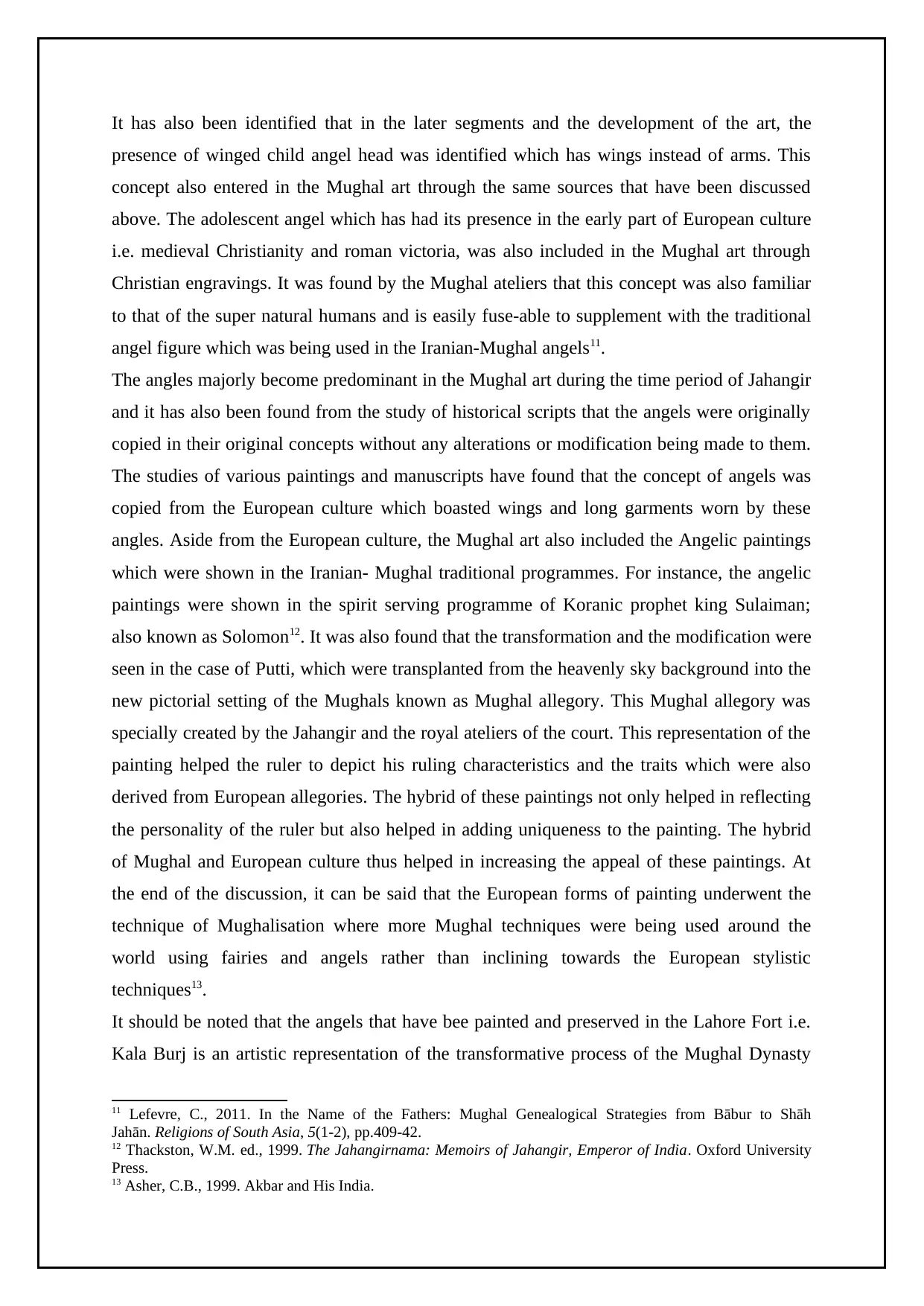
It has also been identified that in the later segments and the development of the art, the
presence of winged child angel head was identified which has wings instead of arms. This
concept also entered in the Mughal art through the same sources that have been discussed
above. The adolescent angel which has had its presence in the early part of European culture
i.e. medieval Christianity and roman victoria, was also included in the Mughal art through
Christian engravings. It was found by the Mughal ateliers that this concept was also familiar
to that of the super natural humans and is easily fuse-able to supplement with the traditional
angel figure which was being used in the Iranian-Mughal angels11.
The angles majorly become predominant in the Mughal art during the time period of Jahangir
and it has also been found from the study of historical scripts that the angels were originally
copied in their original concepts without any alterations or modification being made to them.
The studies of various paintings and manuscripts have found that the concept of angels was
copied from the European culture which boasted wings and long garments worn by these
angles. Aside from the European culture, the Mughal art also included the Angelic paintings
which were shown in the Iranian- Mughal traditional programmes. For instance, the angelic
paintings were shown in the spirit serving programme of Koranic prophet king Sulaiman;
also known as Solomon12. It was also found that the transformation and the modification were
seen in the case of Putti, which were transplanted from the heavenly sky background into the
new pictorial setting of the Mughals known as Mughal allegory. This Mughal allegory was
specially created by the Jahangir and the royal ateliers of the court. This representation of the
painting helped the ruler to depict his ruling characteristics and the traits which were also
derived from European allegories. The hybrid of these paintings not only helped in reflecting
the personality of the ruler but also helped in adding uniqueness to the painting. The hybrid
of Mughal and European culture thus helped in increasing the appeal of these paintings. At
the end of the discussion, it can be said that the European forms of painting underwent the
technique of Mughalisation where more Mughal techniques were being used around the
world using fairies and angels rather than inclining towards the European stylistic
techniques13.
It should be noted that the angels that have bee painted and preserved in the Lahore Fort i.e.
Kala Burj is an artistic representation of the transformative process of the Mughal Dynasty
11 Lefevre, C., 2011. In the Name of the Fathers: Mughal Genealogical Strategies from Bābur to Shāh
Jahān. Religions of South Asia, 5(1-2), pp.409-42.
12 Thackston, W.M. ed., 1999. The Jahangirnama: Memoirs of Jahangir, Emperor of India. Oxford University
Press.
13 Asher, C.B., 1999. Akbar and His India.
presence of winged child angel head was identified which has wings instead of arms. This
concept also entered in the Mughal art through the same sources that have been discussed
above. The adolescent angel which has had its presence in the early part of European culture
i.e. medieval Christianity and roman victoria, was also included in the Mughal art through
Christian engravings. It was found by the Mughal ateliers that this concept was also familiar
to that of the super natural humans and is easily fuse-able to supplement with the traditional
angel figure which was being used in the Iranian-Mughal angels11.
The angles majorly become predominant in the Mughal art during the time period of Jahangir
and it has also been found from the study of historical scripts that the angels were originally
copied in their original concepts without any alterations or modification being made to them.
The studies of various paintings and manuscripts have found that the concept of angels was
copied from the European culture which boasted wings and long garments worn by these
angles. Aside from the European culture, the Mughal art also included the Angelic paintings
which were shown in the Iranian- Mughal traditional programmes. For instance, the angelic
paintings were shown in the spirit serving programme of Koranic prophet king Sulaiman;
also known as Solomon12. It was also found that the transformation and the modification were
seen in the case of Putti, which were transplanted from the heavenly sky background into the
new pictorial setting of the Mughals known as Mughal allegory. This Mughal allegory was
specially created by the Jahangir and the royal ateliers of the court. This representation of the
painting helped the ruler to depict his ruling characteristics and the traits which were also
derived from European allegories. The hybrid of these paintings not only helped in reflecting
the personality of the ruler but also helped in adding uniqueness to the painting. The hybrid
of Mughal and European culture thus helped in increasing the appeal of these paintings. At
the end of the discussion, it can be said that the European forms of painting underwent the
technique of Mughalisation where more Mughal techniques were being used around the
world using fairies and angels rather than inclining towards the European stylistic
techniques13.
It should be noted that the angels that have bee painted and preserved in the Lahore Fort i.e.
Kala Burj is an artistic representation of the transformative process of the Mughal Dynasty
11 Lefevre, C., 2011. In the Name of the Fathers: Mughal Genealogical Strategies from Bābur to Shāh
Jahān. Religions of South Asia, 5(1-2), pp.409-42.
12 Thackston, W.M. ed., 1999. The Jahangirnama: Memoirs of Jahangir, Emperor of India. Oxford University
Press.
13 Asher, C.B., 1999. Akbar and His India.
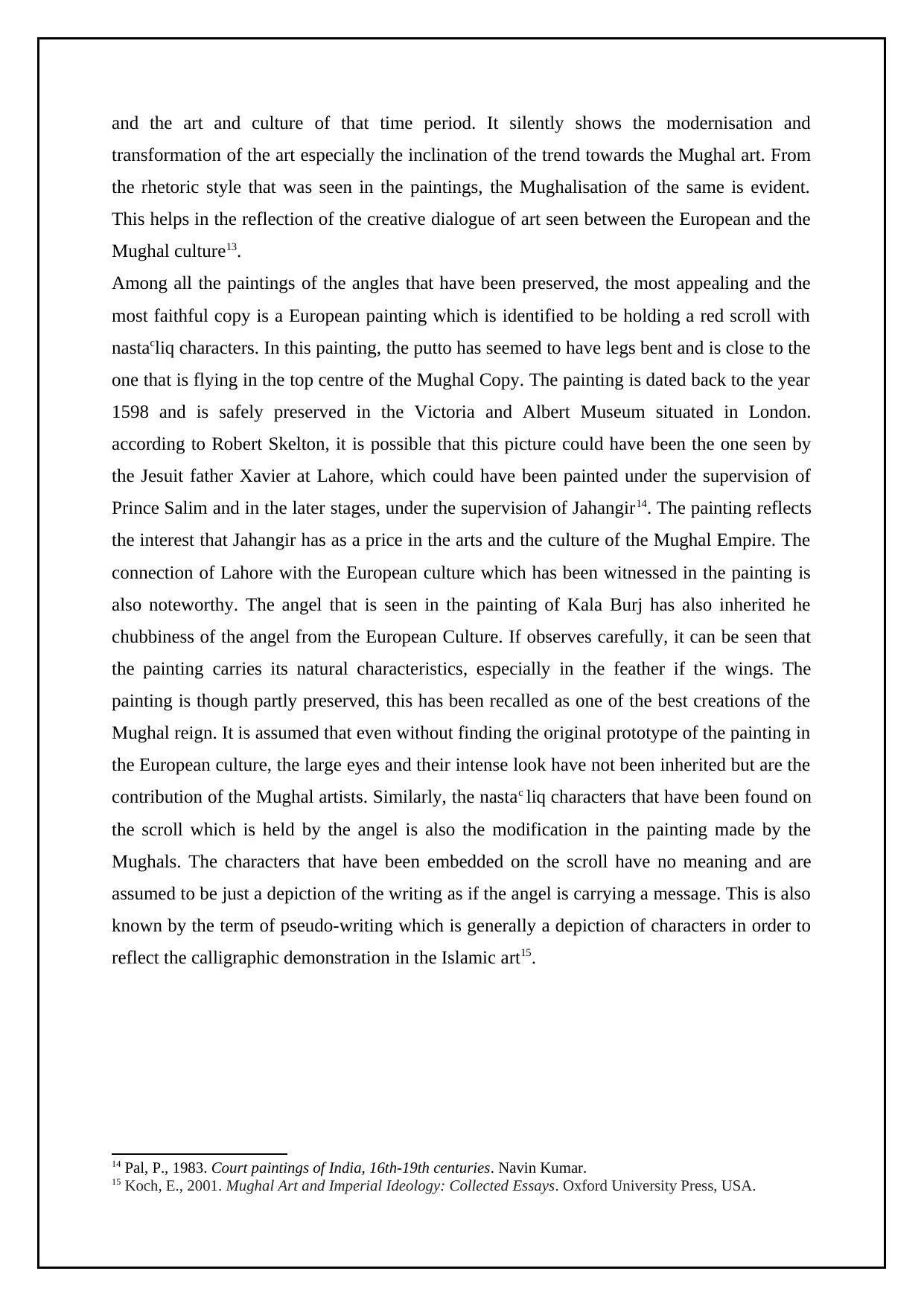
and the art and culture of that time period. It silently shows the modernisation and
transformation of the art especially the inclination of the trend towards the Mughal art. From
the rhetoric style that was seen in the paintings, the Mughalisation of the same is evident.
This helps in the reflection of the creative dialogue of art seen between the European and the
Mughal culture13.
Among all the paintings of the angles that have been preserved, the most appealing and the
most faithful copy is a European painting which is identified to be holding a red scroll with
nastacliq characters. In this painting, the putto has seemed to have legs bent and is close to the
one that is flying in the top centre of the Mughal Copy. The painting is dated back to the year
1598 and is safely preserved in the Victoria and Albert Museum situated in London.
according to Robert Skelton, it is possible that this picture could have been the one seen by
the Jesuit father Xavier at Lahore, which could have been painted under the supervision of
Prince Salim and in the later stages, under the supervision of Jahangir14. The painting reflects
the interest that Jahangir has as a price in the arts and the culture of the Mughal Empire. The
connection of Lahore with the European culture which has been witnessed in the painting is
also noteworthy. The angel that is seen in the painting of Kala Burj has also inherited he
chubbiness of the angel from the European Culture. If observes carefully, it can be seen that
the painting carries its natural characteristics, especially in the feather if the wings. The
painting is though partly preserved, this has been recalled as one of the best creations of the
Mughal reign. It is assumed that even without finding the original prototype of the painting in
the European culture, the large eyes and their intense look have not been inherited but are the
contribution of the Mughal artists. Similarly, the nastac liq characters that have been found on
the scroll which is held by the angel is also the modification in the painting made by the
Mughals. The characters that have been embedded on the scroll have no meaning and are
assumed to be just a depiction of the writing as if the angel is carrying a message. This is also
known by the term of pseudo-writing which is generally a depiction of characters in order to
reflect the calligraphic demonstration in the Islamic art15.
14 Pal, P., 1983. Court paintings of India, 16th-19th centuries. Navin Kumar.
15 Koch, E., 2001. Mughal Art and Imperial Ideology: Collected Essays. Oxford University Press, USA.
transformation of the art especially the inclination of the trend towards the Mughal art. From
the rhetoric style that was seen in the paintings, the Mughalisation of the same is evident.
This helps in the reflection of the creative dialogue of art seen between the European and the
Mughal culture13.
Among all the paintings of the angles that have been preserved, the most appealing and the
most faithful copy is a European painting which is identified to be holding a red scroll with
nastacliq characters. In this painting, the putto has seemed to have legs bent and is close to the
one that is flying in the top centre of the Mughal Copy. The painting is dated back to the year
1598 and is safely preserved in the Victoria and Albert Museum situated in London.
according to Robert Skelton, it is possible that this picture could have been the one seen by
the Jesuit father Xavier at Lahore, which could have been painted under the supervision of
Prince Salim and in the later stages, under the supervision of Jahangir14. The painting reflects
the interest that Jahangir has as a price in the arts and the culture of the Mughal Empire. The
connection of Lahore with the European culture which has been witnessed in the painting is
also noteworthy. The angel that is seen in the painting of Kala Burj has also inherited he
chubbiness of the angel from the European Culture. If observes carefully, it can be seen that
the painting carries its natural characteristics, especially in the feather if the wings. The
painting is though partly preserved, this has been recalled as one of the best creations of the
Mughal reign. It is assumed that even without finding the original prototype of the painting in
the European culture, the large eyes and their intense look have not been inherited but are the
contribution of the Mughal artists. Similarly, the nastac liq characters that have been found on
the scroll which is held by the angel is also the modification in the painting made by the
Mughals. The characters that have been embedded on the scroll have no meaning and are
assumed to be just a depiction of the writing as if the angel is carrying a message. This is also
known by the term of pseudo-writing which is generally a depiction of characters in order to
reflect the calligraphic demonstration in the Islamic art15.
14 Pal, P., 1983. Court paintings of India, 16th-19th centuries. Navin Kumar.
15 Koch, E., 2001. Mughal Art and Imperial Ideology: Collected Essays. Oxford University Press, USA.
⊘ This is a preview!⊘
Do you want full access?
Subscribe today to unlock all pages.

Trusted by 1+ million students worldwide
1 out of 29
Your All-in-One AI-Powered Toolkit for Academic Success.
+13062052269
info@desklib.com
Available 24*7 on WhatsApp / Email
![[object Object]](/_next/static/media/star-bottom.7253800d.svg)
Unlock your academic potential
Copyright © 2020–2025 A2Z Services. All Rights Reserved. Developed and managed by ZUCOL.